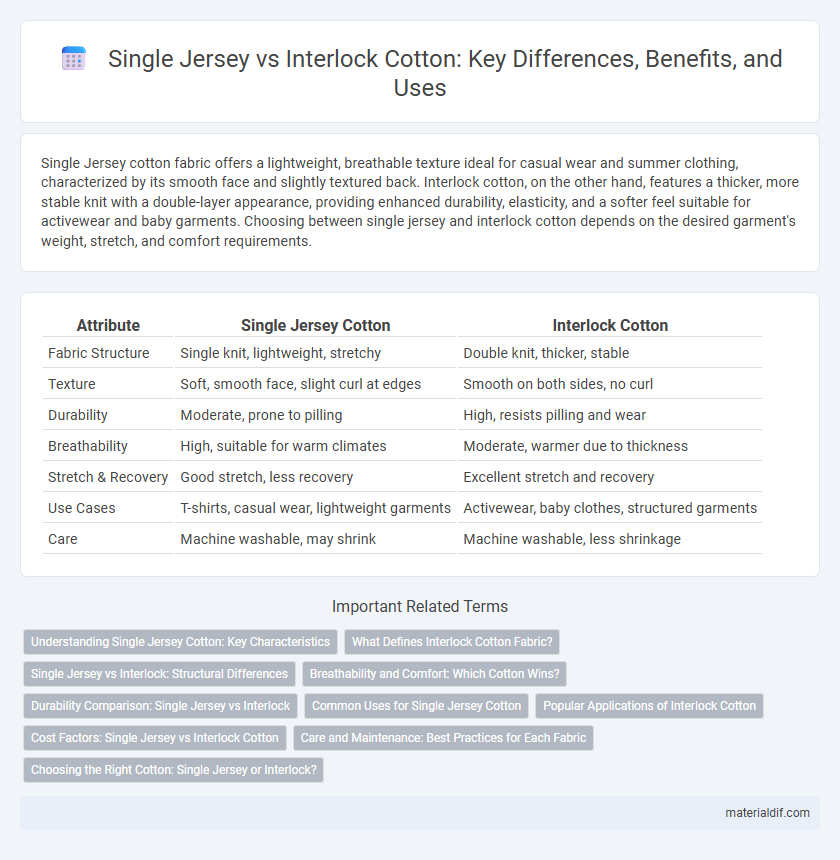Single Jersey cotton fabric offers a lightweight, breathable texture ideal for casual wear and summer clothing, characterized by its smooth face and slightly textured back. Interlock cotton, on the other hand, features a thicker, more stable knit with a double-layer appearance, providing enhanced durability, elasticity, and a softer feel suitable for activewear and baby garments. Choosing between single jersey and interlock cotton depends on the desired garment's weight, stretch, and comfort requirements.
Table of Comparison
| Attribute | Single Jersey Cotton | Interlock Cotton |
|---|---|---|
| Fabric Structure | Single knit, lightweight, stretchy | Double knit, thicker, stable |
| Texture | Soft, smooth face, slight curl at edges | Smooth on both sides, no curl |
| Durability | Moderate, prone to pilling | High, resists pilling and wear |
| Breathability | High, suitable for warm climates | Moderate, warmer due to thickness |
| Stretch & Recovery | Good stretch, less recovery | Excellent stretch and recovery |
| Use Cases | T-shirts, casual wear, lightweight garments | Activewear, baby clothes, structured garments |
| Care | Machine washable, may shrink | Machine washable, less shrinkage |
Understanding Single Jersey Cotton: Key Characteristics
Single Jersey cotton fabric features a lightweight, breathable knit with a smooth face and a slightly textured back, making it ideal for t-shirts and casual wear. This knit structure offers excellent stretch and recovery due to its single set of needles, providing comfort and flexibility. The fabric's moisture-wicking properties and softness enhance wearability, while its versatility supports various printing and dyeing techniques.
What Defines Interlock Cotton Fabric?
Interlock cotton fabric is defined by its double-knit construction, featuring two layers of jersey knit interlocked together for enhanced thickness and durability. This structure provides a smoother surface on both sides, higher stretch recovery, and improved insulation compared to single jersey cotton. Its robust nature makes interlock cotton ideal for activewear and garments requiring superior comfort and resilience.
Single Jersey vs Interlock: Structural Differences
Single Jersey cotton fabric features a single knit structure, characterized by distinct vertical ribs on the front and smooth horizontal loops on the back, offering lightweight breathability and moderate stretch. Interlock cotton fabric consists of two single jersey layers knitted together, creating a thicker, smoother, and more stable fabric with superior durability and reduced curl at the edges. The structural difference impacts the fabric's weight, stretchability, and texture, with single jersey suited for casual wear and interlock preferred for garments requiring extra robustness and a softer hand feel.
Breathability and Comfort: Which Cotton Wins?
Single jersey cotton offers superior breathability due to its lightweight, looser knit structure, making it ideal for hot climates and activewear. Interlock cotton, characterized by its double-knit construction, provides enhanced softness and durability but compromises some airflow, resulting in less breathability. For those prioritizing comfort through ventilation, single jersey cotton wins, while interlock cotton excels in a cozy, thicker fabric feel.
Durability Comparison: Single Jersey vs Interlock
Single jersey cotton fabric, characterized by its lightweight and stretchable knit, offers moderate durability suitable for everyday wear but may be prone to pilling and minor fabric distortion over time. Interlock cotton, featuring a double-knit construction, provides superior durability with enhanced resistance to stretching, pilling, and wear, maintaining its shape and softness after repeated washing cycles. When comparing durability, interlock cotton outperforms single jersey by delivering a thicker, more resilient fabric ideal for garments requiring longevity and sustained structural integrity.
Common Uses for Single Jersey Cotton
Single Jersey cotton is widely used in casual wear, including t-shirts, dresses, and lightweight tops, due to its soft texture and breathable properties. Its single-knit construction offers good stretch and moisture absorption, making it ideal for everyday clothing and activewear. This fabric is favored for comfortable, form-fitting garments that require flexibility and ease of movement.
Popular Applications of Interlock Cotton
Interlock cotton, known for its double-knit structure, offers superior thickness, stretch, and durability compared to single jersey cotton, making it ideal for high-quality activewear, children's clothing, and loungewear. Its smooth surface and enhanced elasticity provide excellent shape retention and comfort, preferred in garments that require both softness and resilience. Popular applications include T-shirts, leggings, and baby wear where breathability and durability are critical.
Cost Factors: Single Jersey vs Interlock Cotton
Single Jersey cotton fabric is generally more cost-effective due to its simpler knit structure, requiring less yarn and manufacturing time compared to Interlock cotton. Interlock cotton, featuring a thicker, double-knit construction, demands more raw materials and labor, leading to higher production costs. Price differences between Single Jersey and Interlock cotton impact product pricing, with Interlock typically used for premium garments requiring durability and softness.
Care and Maintenance: Best Practices for Each Fabric
Single Jersey cotton requires gentle washing with mild detergents and cold water to maintain its softness and elasticity, avoiding high spin speeds to prevent fabric distortion. Interlock cotton, being thicker and more durable, tolerates slightly warmer washes and slower drying settings while retaining its shape and minimizing pilling. Both fabrics benefit from air drying and low-heat ironing, but Interlock cotton generally withstands frequent laundering better due to its double-knit structure.
Choosing the Right Cotton: Single Jersey or Interlock?
Single Jersey cotton fabric offers a lightweight, breathable texture ideal for casual wear and summer clothing, while Interlock cotton provides a thicker, more durable knit perfect for colder climates and activewear. Single Jersey's single-knit construction results in a softer drape and greater stretch, whereas Interlock's double-knit technique creates a smoother surface with enhanced stability and less shrinkage. Selecting the right cotton depends on the intended use, balancing breathability and flexibility of Single Jersey against the warmth and resilience of Interlock.
Single Jersey vs Interlock Cotton Infographic

 materialdif.com
materialdif.com